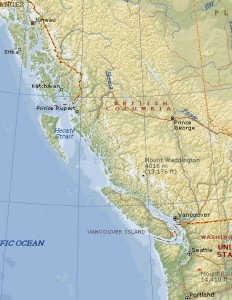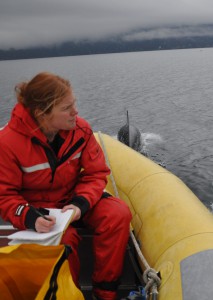 Alumni
Alumni
MSc 2012
Tel: 604.822.8181 Fax: 604.822.8934
E-mail: e.rechsteiner@oceans.ubc.ca
Supervisor: Dr. Andrew Trites
Education: B.Sc. Biology & Geography (Vancouver Island University)
Research Interests: Foraging ecology, predator-prey dynamics, bioenergetics, animal behaviour, cetacean biology
Research Area: West Coast British Columbia
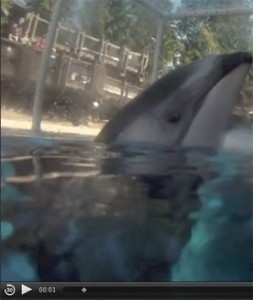 CLICK TO VIEW VIDEO
CLICK TO VIEW VIDEO
Check out our research in action!
Diet, Distribution and Food Requirements of Pacific white-sided dolphins on the British Columbia Coast
Problem
Pacific white-sided dolphins are an abundant cetacean in coastal British Columbia. These dolphins were thought to be an open-ocean species during much of the 20th century. Since the late 1980’s sightings of dolphins in inside waters have increased – possibly due to a shift in prey availability. The increased sightings of Pacific white-sided dolphins on the coast has generated interest in potential interactions between dolphins and local fish populations. Seasonal influxes of dolphins to coastal waters may be triggered by seasonally varied energetic needs, and dolphin distributions may be prey-linked. Dolphins may rely on schools of high calorie forage fish in BC waters to sustain energetic requirements. The interactions between dolphin populations and local fish species cannot be estimated without first understanding energetic requirements and diet of the dolphins.
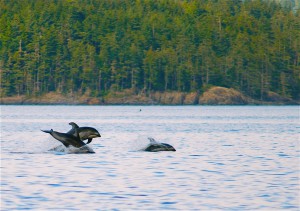
Pacific white-sided dolphins in Blackney Pass, BC
Research Questions
I am addressing the following questions: 1) What are the daily prey requirements of individual dolphins and of the population of dolphins in BC? 2) What are the resting and field metabolic rates? 3) What patterns predict dolphin distribution in BC, and do dolphin and prey distributions overlap seasonally?
Approach
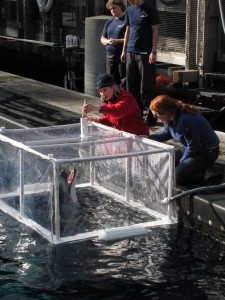
Respirometry Chamber
I am combining bioenergetics modeling, captive animal study and field data collection to address my research questions. I have built a preliminary model to estimate caloric requirements based on data found in the literature. I tested the sensitivity of model outputs to different inputs and found that the two most important predictors of caloric needs are the resting metabolic rate and the activity state of dolphins.
In light of this, we have begun a study at the Vancouver Aquarium to measure the resting metabolic rate of three captive Pacific white-sided dolphins. This is a physiological measurement that will apply to both captive and wild animals.
The resting metabolic rate accounts for energetic costs of basic body functions but does not account for energetic costs of activity. I am working in the field to collect an activity budget and mean speeds of activity states of wild dolphins. These data will be used to assign caloric costs to activities.
The model predicts caloric needs of the dolphins, which are most useful when combined with diet information. I have collected stomachs of stranded dolphins and prey fragments from foraging dolphins. I am also reviewing literature on seasonal Pacific white-sided dolphin diets, and combining my data with other known diet information in collaboration with the Department of Fisheries and Oceans (DFO). Dolphins eat various species of squid and fishes, which have different energetic densities. By determining the calories dolphins ingest based on different prey choices, I will estimate the biomass of prey that dolphins require to meet their energetic demands.
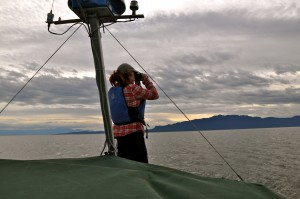
Looking for dolphins in Malaspina Strait
Because the energetic densities of important forage fish prey in dolphin diet (i.e. herring) change seasonally, I hypothesized that dolphins may switch diet compositions seasonally and that their distribution may be correlated with high energy, important food sources. For example, I am testing the idea that dolphins move to nearshore waters when herring come in to spawn, or that their occurrence is high near freshwater inputs when salmon move into river systems in fall.
I am working with the BC Cetacean Sightings Network to map seasonal dolphin and prey distributions to answer further questions about dolphin diet and foraging ecology. Once I have identified hot spots of predator-prey overlap I will return to the field to collect prey samples and see if spatial correlations of predator and prey may provide good hypotheses for prey choices.
Preliminary Findings
My model suggests that adult dolphins require about 15, 000 kcal per day. Pregnant animals require only marginally more calories and lactating animals require nearly 50% more food. Juveniles and calves require less food than adults as a result of their smaller size, however, per kg food requirements are highest for juveniles as they have elevated metabolic rates and high energy growth requirements.
Model predictions are most sensitive to changes in metabolic rate and activity. Preliminary resting metabolic rate results suggest dolphins require more calories to maintain basic functions than previously thought. As we collect more data at the Vancouver Aquarium, refined model outputs will allow us to predict the biomass of local fish required to sustain local dolphin populations in BC waters.
Stomach content analysis and prey fragment collections in the field show that herring, salmon, and sardine are important in the diet of Pacific white sided dolphins. Temporal and spatial correlations between dolphins and prey are being investigated.
Preliminary spatial analysis suggests dolphin distributions in BC show seasonal offshore to onshore movements, perhaps as a reflection of seasonal prey availability, and that shelf and slope waters are important habitat for this species. Highest sightings per unit effort of dolphins occur along the central, near-shore BC coast in winter, and offshore in summer.
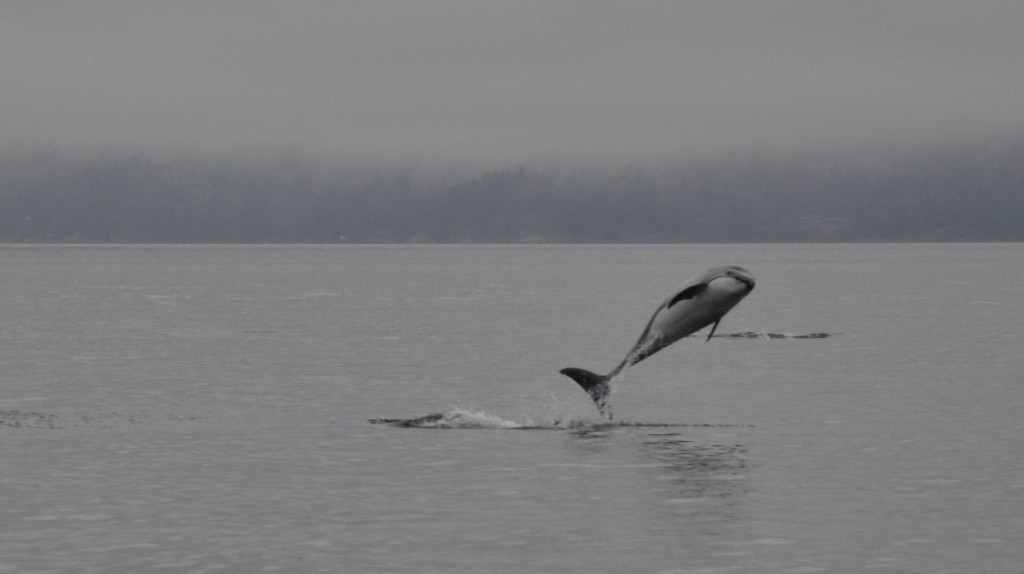
Dolphin leaping in Howe Sound
Research in the News
http://www.vancouversun.com/
http://www.bclocalnews.com/greater_vancouver/northshoreoutlook/news/119799829.html
http://wildwhales.org/2010/07/the-dolphin-diet/
http://www2.canada.com/nanaimodailynews/story.html?id=a55913fa-cacc-4ba9-8e5f-1daaa04cf071
Presentations
Rechsteiner, E. 2011. Seasonal distribution of Pacific white-sided dolphin in British Columbia waters. 19th annual B.C. Marine Mammal Symposium, Northwest Student Chapter of the Society of Marine Mammalogy, Univeristy of British Columbia, Vancouver, B.C.
Rechsteiner, E*., Barrett-Lennard, L., Ford, J.K.B., & Trites, A.W. 2011. Natural history, diet, distribution, and foraging ecology of Pacific white-sided dolphins. 25th Annual Pacific Rim Whale Festival. Pacific Rim National Park Reserve, Vancouver Island, B.C.
Rechsteiner, E. 2010. Diet, distribution, and food requirements of Pacific white-sided dolphins in BC. 18th annual B.C. Marine Mammal Symposium, Northwest Student Chapter of the Society of Marine Mammalogy, Western Washington University, WA, USA.
Rechsteiner, E.*, Flottat, P., Millar, C., Trites, A.W. 2010. A bioenergetics model to predict the food requirements of Pacific white-sided dolphins. Canadian Society of Zoologists Conference, Vancouver, B.C.
Rechsteiner, E.*, Flottat, P., Millar, C., Trites, A.W. 2010. A bioenergetics model to predict the food requirements of Pacific white-sided dolphins. Northwest Student Chapter Meeting for the Society of Marine Mammalogy. Western Washington University, Seattle, W.A., U.S.A.
Rechsteiner, E*., & Trites A.W. 2009. Food requirements of Pacific white-sided dolphins: How much do they need? 17th annual B.C. Marine Mammal Symposium, Northwest Student Chapter of the Society of Marine Mammalogy, Univeristy of British Columbia, Vancouver, B.C.
Rechsteiner, E. 2008. Size-selective and species-selective predation by the painted sea star, Orthasterias koehleri on three sympatric species of subtidal gastropods. Western Society of Naturalists Annual Meeting, Vancouver, B.C.
Anaka J., Berlinghof S., Flood S., Ramsden K., Rechsteiner, E., Stinchocombe M.*. 2006. A field based investigation of Nanaimo’s urban heat island effect. Western Division: Canadian Association of Geographers Conference, Kamloops, B.C.
Technical Reports
Rechsteiner, E. 2006. Baikie Island Preserve Ecological Baseline Monitoring Report. Nature Conservancy of Canada, Victoria, B.C.
Rechsteiner, E. 2006. North Vancouver Outdoor School Ecological Baseline Monitoring Report. Nature Conservancy of Canada, Victoria, B.C.
Photo credits
From top of page to bottom: Rod MacVicar, Erin Rechsteiner, Nicole Cann, Matthew Foster, Erin Rechsteiner.
|
Links I am appreciative of the help and support provided by: |
||||

